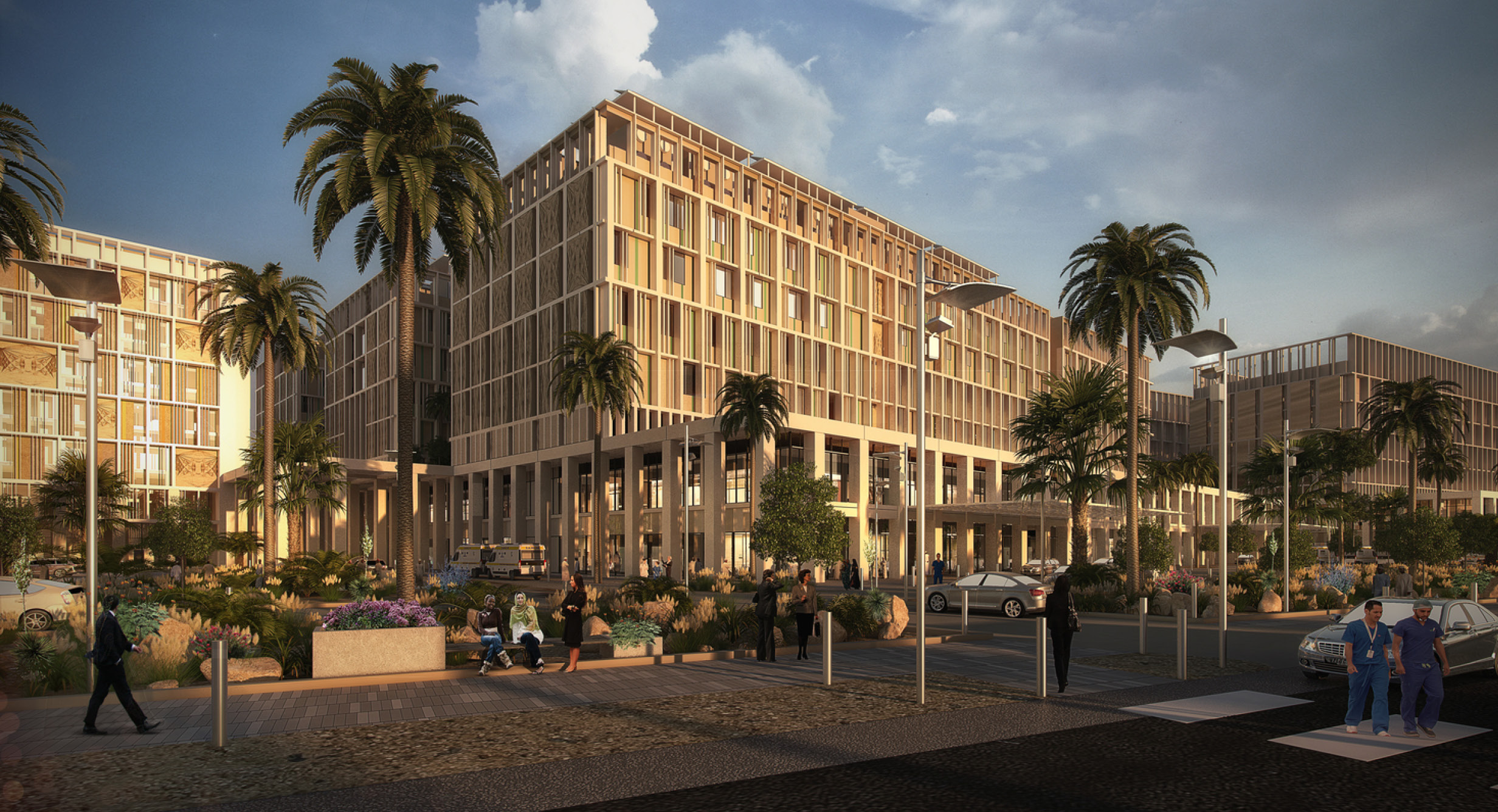
Seven Considerations for Health Care Design in the Middle East
- Ala Hason
- Ben Gonzalez
The Middle East is steeped in rich heritage and cultural subtleties, so designing the region’s next generation of health care facilities requires a nuanced approach. Each year, the Global Health Exhibition in Riyadh, Saudi Arabia, brings health care professionals together to connect and drive health care innovation in the region. Please visit global design firm HKS at our booth at Riyadh Front Exhibition and Conference Center from Oct. 29 to Oct. 31, 2023, as we reflect on the various ways HKS addresses key Middle Eastern cultural and environmental characteristics through our award-winning health care designs.
Responding to the Climate with Vernacular Architecture
With temperatures hovering at 40 degrees Celsius (104 degrees Fahrenheit) in the shade for more than half the year, a building’s orientation is one of our first considerations when planning new structures. The site location of Kuwait Children’s Hospital required the HKS team to design patient windows to face east and west. Solar studies were performed to create sophisticated shading systems on both sides of the building to not only reduce solar gain but also reduce glare and enhance comfort within patient rooms. Catwalks on every other floor allow easy cleaning of the windows and shading systems after humid dust storms characteristic of the region. Canopies over outdoor respite areas are necessary for a large portion of the year, and HVAC systems need to be powerful, durable and efficient to minimize energy consumption.
Water is a Precious Commodity in the Desert
Because much of the region relies on desalination plants to provide water, irrigation is strictly regulated. Through the use of regional plant life such as Ghaf trees, we provide xeriscaping to minimize water usage. On-site water recycling plants efficiently irrigate green spaces.
During transportation, water is warmed by intense heat and must be cooled before use. Brutal sunlight means that roof storage isn’t an option for cooling. Some jurisdictions, such as Kuwait, require water be stored in subterranean tanks or cooling towers before it is distributed. Pumps are then required to move water to its destination. Further, the use of large water features is discouraged due to the high evaporation ratio year-round.
Designing for Cultural Subtleties and Privacy
The Middle East can appear to be one large desert to some, but each country has specific cultural interests. Some countries are more conservative than others, and thus, understanding how varying cultural and religious customs can affect traffic patterns throughout a hospital is important. For example, some hospitals may include separate waiting rooms for men and women or an emergency room with an entrance split in different directions for men and women. Prayer rooms for men and women, and sometimes even mosques, are incorporated into convenient locations of our designs.
Some clients prefer traditional architecture to help patients feel comfortable, especially as health care can be a sensitive topic in the Middle East — many patients prefer not to share details about their health. Health care facilities such as Prince Sattam University Hospital in Al Kharj, Saudi Arabia, are in conservative agricultural areas outside of urban centers. Sensitivity to the local community is important, so the team focused on developing a design that utilizes local stone for the exterior facades. To reduce the sense of anxiety while providing familiarity to the agriculture community, the project was organized around a wadi, or valley, including natural elements that blend into the lobby. The National Rehabilitation Clinic (NRC) in Abu Dhabi also employs vernacular architecture to ease anxiety.
Planning for Large Families
Families tend to be larger in the Middle East than in western countries, and rather than one or two visitors, a patient might receive six or eight at a time. Patient rooms are designed with patient, caregiver and family zones, and public areas are designed to accommodate multiple families.
Incorporating amenities in public spaces is a priority. Kuwait Children’s Hospital’s five-story atrium stretches nearly 1,500 feet and includes a hollow whale where movies are played, cafes, and other elements that blend health care, hospitality, and retail. We developed outdoor courtyards for Prince Sattam University and the NRC to allow families, or even patients, to walk away and take a break from the hospital.
Sustainability
Rising energy costs and a harsh climate mean that sustainability is being pushed to the forefront of the region’s unique challenges. Dubai, for example, requires a sustainability checklist when submitting building permits, and other countries require a minimum of LEED-Silver equivalent design for government hospital projects. Our exterior design for Prince Sattam resulted in a 30% reduction of energy. Designers must continue to encourage clients and peers to support energy efficient initiatives.
Rapid Growth
The Middle East has a large middle-income class with growing expectations, and HKS is creating the next generation of health care facilities to meet the region’s needs. Dubai and some other cities have almost quadrupled in size over the last 20 years, and health care investment is struggling to keep pace.
Private providers are beginning to invest in new facilities. Hospitals such as Danat Al Emarat, a private maternity hospital, are successful examples of an efficient and financially responsible project meeting the needs of Abu Dhabi. HKS has been involved with several teaching hospital campuses, including CapitalMED Medical City in Egypt and Prince Sattam University Hospital, in the ongoing challenge to meet the region’s demand for experienced physicians.



